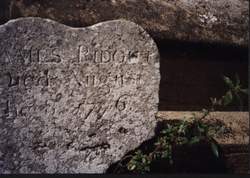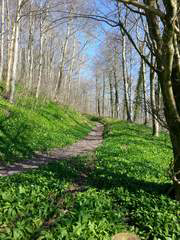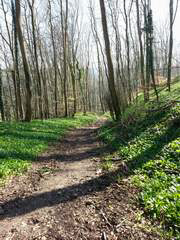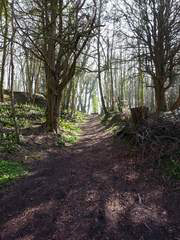Abandoned Communities ..... Milton
We have seen that the map of 1769 shows that some of the properties in Milton were already "in hand", but the majority were occupied by one or more "lives". A map of Milton produced about 1776 indicates that only a few properties were still in existence. In the intervening seven years all the rest had been cleared away. Most of the area of the town became open parkland, with some of the roads preserved across it. A property occupied by Stephen Wood at the western border of the estate has become Lord Milton's Orchard and Flower Garden, while the adjacent properties, previously occupied by William Muckles, John Halett, and Francis Vacker, are now Lord Milton's Kitchen Garden.
I have not yet been able to find out how it was so easy for Joseph Damer to evict so many tenants in such a short period of time. I would very much like to know more about the types of leases held by the people of Milton. A few residents may have died between 1769 and 1776, and a few may have had leases that came to an end during this time. The remainder were presumably offered terms by Damer to which they were willing to give their agreement, or perhaps Damer used additional methods to encourage residents to consider moving away.
At the same time Damer took legal action to close several roads running through his estate. Roads leading north east towards Blandford Forum and north west in the direction of Sherborne were closed. Soon afterwards White Hill Road and Hollow Way, both shown on the 1769 map reproduced on page 2 of this section, were closed. These road closures would have made it impossible to maintain trade routes into and through the town.
I am grateful to Helier Exon for drawing my attention to the road closures. More information about them is given in The Tale of Milton Abbas by Richard Wansbrough, who used records of the Dorset Quarter Sessions Orders, now held in the Dorset History Centre.
Some tenants were offered the opportunity to move to the new village of Milton Abbas, constructed at that time in a secluded valley east of the old town and out of sight of the main house. As buildings in the town of Milton were demolished any re-usable materials were transported to Milton Abbas and used again. In the new village the almshouses were re-constructed more or less as they had been before.
One family that moved from the old town to the new village were the Ridouts. There had been Ridouts at Milton since the sixteenth century when they had been Able Archers at the Tudor Musters. In the mid 1700s a Ridout supplied new bell leathers for the church, and after the move they were recorded as coppice workers. James Ridout died in August 1776.
In 1991, when the photograph at the foot of the page was taken, James Ridout's humble gravestone was standing against the wall of the abbey.
The final stages of the transformation of Milton proved to be more difficult for Joseph Damer. For one thing, he had to contend with stiff opposition from a lawyer named William Harrison, who had leases on four properties in various parts of the town. Harrison had no wish to surrender his leases. Damer showed his displeasure by opening the sluice gates of an old pond and allowing the water to flood one of Harrison's houses. Harrison took legal action and eventually won the case. The process of emparking could not be completed until William Harrison died.
At first Damer appeared willing to tolerate the continued existence of the grammar school. However, his patience began to wear thin when pupils trespassed on his private property, stealing fruit and disturbing the game. One group of pupils had to be expelled for "persistent stone-throwing down chimneys, and for stealing cucumbers from the Abbey gardens and game fowl eggs for the purpose of rearing birds to compete in fighting." T M Hardy, who later in life became famous for being asked by Lord Nelson to kiss him, while a pupil at the school was in trouble for letting the son of the headmaster down the church tower by rope to collect a bird's nest.
In 1784 Damer introduced a bill in parliament to have the school moved to Dorchester. The bill failed, but in the following year Damer introduced a similar bill, proposing a move to Blandford. This time the bill was passed and the school had to move.
I have not yet been able to find out how it was so easy for Joseph Damer to evict so many tenants in such a short period of time. I would very much like to know more about the types of leases held by the people of Milton. A few residents may have died between 1769 and 1776, and a few may have had leases that came to an end during this time. The remainder were presumably offered terms by Damer to which they were willing to give their agreement, or perhaps Damer used additional methods to encourage residents to consider moving away.
At the same time Damer took legal action to close several roads running through his estate. Roads leading north east towards Blandford Forum and north west in the direction of Sherborne were closed. Soon afterwards White Hill Road and Hollow Way, both shown on the 1769 map reproduced on page 2 of this section, were closed. These road closures would have made it impossible to maintain trade routes into and through the town.
I am grateful to Helier Exon for drawing my attention to the road closures. More information about them is given in The Tale of Milton Abbas by Richard Wansbrough, who used records of the Dorset Quarter Sessions Orders, now held in the Dorset History Centre.
Some tenants were offered the opportunity to move to the new village of Milton Abbas, constructed at that time in a secluded valley east of the old town and out of sight of the main house. As buildings in the town of Milton were demolished any re-
One family that moved from the old town to the new village were the Ridouts. There had been Ridouts at Milton since the sixteenth century when they had been Able Archers at the Tudor Musters. In the mid 1700s a Ridout supplied new bell leathers for the church, and after the move they were recorded as coppice workers. James Ridout died in August 1776.
In 1991, when the photograph at the foot of the page was taken, James Ridout's humble gravestone was standing against the wall of the abbey.
The final stages of the transformation of Milton proved to be more difficult for Joseph Damer. For one thing, he had to contend with stiff opposition from a lawyer named William Harrison, who had leases on four properties in various parts of the town. Harrison had no wish to surrender his leases. Damer showed his displeasure by opening the sluice gates of an old pond and allowing the water to flood one of Harrison's houses. Harrison took legal action and eventually won the case. The process of emparking could not be completed until William Harrison died.
At first Damer appeared willing to tolerate the continued existence of the grammar school. However, his patience began to wear thin when pupils trespassed on his private property, stealing fruit and disturbing the game. One group of pupils had to be expelled for "persistent stone-
In 1784 Damer introduced a bill in parliament to have the school moved to Dorchester. The bill failed, but in the following year Damer introduced a similar bill, proposing a move to Blandford. This time the bill was passed and the school had to move.
Four
Gravestone of James Ridout.
This photograph was supplied by Carol Sastradipradja
The remains of Ice Drove
The road down Fishmore Hill
St Catherine’s Hill
These three photographs have been supplied by Helier Exon



